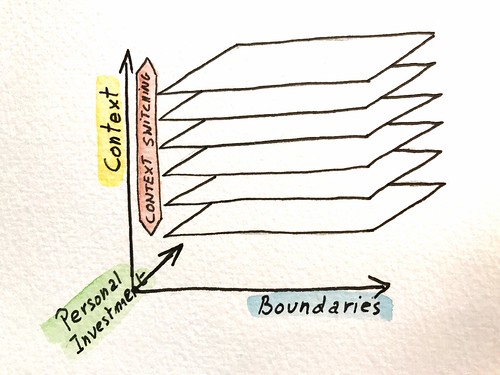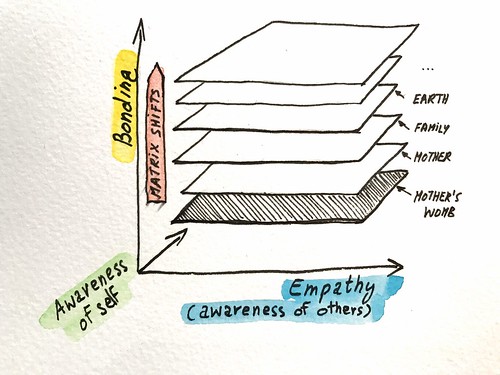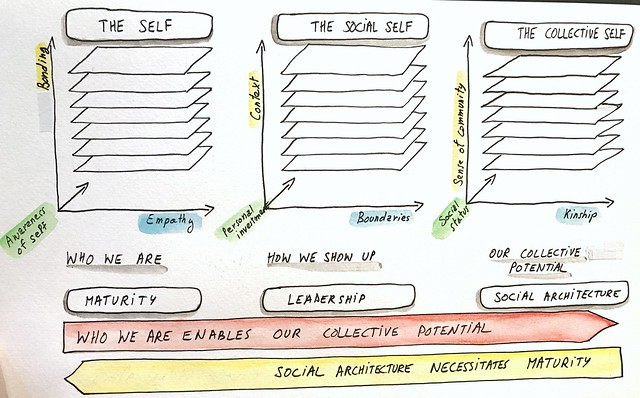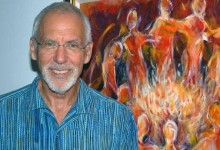The purpose of this article is to define the type of leadership that is needed for Social Architecture. It turns out that we need more, not less, leadership in a Social Architecture.
Are you serious about collective engagement? About what it takes for the whole to be greater than the sum of its parts? Are you after the potential that is only available when it is accessed collectively? Then you need to be serious about Social Architecture: because without it we are stuck in Flatland where the whole at best equals the sum of its parts.
Getting started
When we want to define leadership we need to address how we show up in the first place. But before doing so, we dive one level deeper into identity because ‘who we are’ is inseparable from ‘how we show up’. Once we see the construct of what defines us, and how it drives us, we can investigate how it connects us.
It turns out that leadership is not a science , so there is no generally accepted definition to begin with. From Wikipedia we learn that it is the ability of an individual or organization to “lead” or guide other individuals, teams, or entire organizations.
It pretty much depends on how you look at individuals and organizations; so let’s start there. These are the basic assumptions we make:
1. Organizations are communities to develop, not machines to fix.
2. People are resourceful.
3. Intelligence is the ability to interact.
As we will be tracing leadership through the lenses of the collective potential of an organization, it is helpful to understand what it is composed of and what the governing dynamics are. Here is the plan: the below drawing gives an overview of what we need to investigate before we address leadership.
Let’s start somewhere in the middle, since leadership is about how we show up.
The Social Self: How We Show Up
There is a simple and effective way to find out how people express their identity: just by asking them who they are. Imagine you are at a dinner party and there is no one you have met before. How will you introduce yourself? Chances are that you will identify yourself by means of your affiliation with a group or a community.
For example: ‘Hi, my name is Luc and I’m the brother of the host of this party.’ Another example: ‘Hi, my name is Luc and I come from Belgium; I am an independent organizational change practitioner.’ Or how about: ‘Hi, my name is Luc, I am the dad of Marie, Jolien and Dries; we live in the town across the highway.’ These are three ways I have introduced myself in the past on three different occasions. When you pay attention you will note that there is a recurring pattern that is visible in the above examples; i.e.: how we expose our identity:
- First, we derive our identity from the groups we belong to (my family, my profession, my nation,…). Our membership is based on the boundaries of those communities; so we know who is in and who is not. The fact that I feel part of a community or that I feel like an outsider provides the boundaries we need to construct our identity.
- Second, the communities I am most likely to identify with are those in which I play an active role. In other words: those places where I make a personal investment of some sort (time, attention, vulnerability) and where I feel I am making a difference.
- Third, the identity that we display is different when we are in a different situation, because there are other things that are setting us apart or make us belong together… When I am at a dinner party in another country I will be more likely to refer to the group of Belgians as ‘us’, but as soon as we are on our way back I will look for other cues to set me apart from some members and pull me closer to other members of the Belgian cohort: age, gender, shared hobbies, education, etc… The situation I am in defines the boundaries and therefore determines who I am at that moment.
Let’s have a closer and more analytic look at this pattern. If we were to make a logical deduction of how people give expression to who they are, it would come down to the following equation:
Social Self = f(Personal Investments, Boundaries, Context)
The Social Self, or in other words ‘How we show up’ is a reflection of the communities we are actively part of. The best way to visualize this is a 3D graph, where each layer represents a different context.
We choose the boundaries and the level of personal investment that are most appropriate to blend in with the social script of the context we are in. But the most elegant part of the Social Self is hidden in context switching; i.e.: being part of one context does not cancel out our membership of another context at the same time. We are all of our contexts, all of the time, at the same time.
Always remember: never mistake what you see for what you get; how people show up is just one layer of the richness of layers that a person embodies. What we see is only the tip of the iceberg.
The Self: Who We Are
You are not a drop in the ocean. You are the entire ocean in a drop. (Rumi)
Before we can move on to the Collective Self, we need to investigate the space where the layers of the Social Self find their origins. We call it the ‘Self’.
Joseph Chilton Pearce, who passed away at the age of 90 in 2016, spent an entire part of his life on the researching the the development of the self. We are especially interested in Pearce’s concept of a matrix, the Latin word for womb, which he defined as:
A source of possibility, a source of energy to explore that possibility, and a safe place within which that exploration can take place.
Matrix is the closest we can get to the origins of the layers that form the make-up of our psyche.
Every child’s first matrix is literally the mother’s womb, but nature’s blueprint for human development provides for several matrix shifts: from the womb to the mother to the earth (an ever-widening circle of the terrain surrounding the mother) to the self (becoming one’s own matrix) to increasingly abstract matrices of higher consciousness.
Progress into a new matrix is made only by standing on the old, i.e., a child can move into exploration of the earth matrix only by standing on the safe place provided by mother. Also, moving on to a next matrix does not cancel out the previous matrix; as we grow older we embody more and more of those layers through so-called matrix-shifts. So, again, let’s apply some logic and try to boil this down to an equation:
Self = f(Awareness of Self, Empathy, Bonding)
Here as well, the best way to represent this graphically is in three dimensions, where each matrix is a layer that we embody as we move from one level of intelligence to the next.
The research in neuroscience and development psychology points out that early bonding during the first 18 months of childhood has a lifelong impact. The failure of an adult to bond socially and to become an active member of society, is the failure of not having established that bond as a child on which the later social bonds must be built.
Neuroscientist Antonio Damasio points out that our intellectual and creative development depend on our emotional development; i.e.: our capacity of bonding. His research shows that our cognition is limited by the emotional system. If we want to develop higher levels of intelligence, we must first of all have a thoroughly developed emotional-cognitive system during childhood.
In other words, the first layers of matrix seem to be fundamental for all further development of the Self and the Social Self. Instead of ‘The Social Self’, Damasio uses the label ‘autobiographical self‘ to refer to an individual’s lived past and anticipated future. These form the basis of our Collective Self – in his words: ‘the instruments of culture’, i.e.: religions, justice, trade, the arts, science, technology.
The Collective Self: Our Collective Potential
We think we see the world as it is, when in fact we see the world as we are. (Stephen R. Covey)
What keeps us awake at this level is the potential of collective engagement: how do we show up in a way that it opens up possibilities that are not available to us as an individual? The first two dimensions of Status (how power is distributed) and Kinship (how I relate to other members) define the Social Script of an organization.
We referred to this as Flatland. We then introduced the third dimension, called Sense of community (how people engage collectively), because with the social script of kinship and status alone we can’t get any further than ‘1+1=2’. Sense of Community allows us to see spaces of engagement with possibilities that are not available to us as an individual. Possibilities that can only be accessed collectively.
All layers of the Collective Self create a sense of community through a balance of social status and kinship across different communities. Here is what the equation looks like:
Collective Self = f(Status, Kinship, Sense of Community)
The graphical representation of the collective self is one that we have addressed in earlier articles on community development, but never before have we made the link explicit with the Social Self and the Self.
This linkage and the awareness that we are talking about the exact same dimensions and dynamics on a different scale is essential to understand before we can move onto leadership. If we fail to see how the Self, the Social Self and the Collective Self are linked, we will draw false conclusions as to what leadership means in a Social Architecture.
Bringing it all Together
Now that we have a deeper understanding of the Social Self we know that it is deeply rooted in the way the Self develops and that it starts before we are born. It’s also important to understand that the mechanics that apply to context switching are rooted in the mechanics of matrix shifts. So both the structure and dynamics of the Social Self reflect those of the Self.
So it shouldn’t come as a surprise that our model of the Collective Self contains an aggregation of the three dimensions, the layers, and the way they work. Earlier we pointed out that Social Architecture is being intentional about a third dimension called Sense of Community. The bigger picture now shows us the importance of bonding to that end, or to put it in a more acceptable language: our capacity for connectedness.
The point is that long before community can be manifest in outward relationships (the Social Self, and ultimately the Collective Self), it must be present in the Self.
Neuroscientists and experts on child development are pointing out that accessing a higher evolutionary layers of collective intelligence can only take shape when the foundations of a matrix are present:
- a source of possibility,
- a source of energy to explore that possibility, and
- a safe space within which that exploration takes place.
When we investigated what it takes for people to be accountable we placed out bets on legitimate authority, a form of power that is based on voice, predictability and fairness.
More Leadership, Not Less
The question we are up against is this: is legitimate authority by one leader enough do justice to the untapped potential of the Collective Self? You may be afraid to know the answer… it isn’t. As you read the title of this paragraph you may think that we meant to say ‘more powerful’ leadership, but that is not the case either.
We need more people who assume the the leadership-role.If we want to tap into the potential of the Collective Self we need to flip the assumption that leadership resides only with one individual. Leadership is what we must seek within all members of a community. The legitimate authority to lead in a Social Architecture can emerge from anyone in an organization—and it may even be more likely to emerge from people who do not hold positional power. To say it in the words of Peter Block (taken from his 2009 book Community, the Structure of Belonging):
Leadership that engages citizens is a capacity that exists in all human beings. It is infinitely and universally available.
A critical assumption here is that people are resourceful. This goes against a widespread assumption that people are defined by their scarcities rather than their gifts, so the organization must take care of them. These practices disempower people and take away the opportunity for them to hold each other accountable. Instead of asking “What can we create together?”, we end up helplessly asking “What’s In It For Me?”.
Many of us have been persuaded by institutions that we do not have the resources it takes to do things, or even think things, for ourselves. There are quite some unspoken reciprocal expectations that bosses and subordinates have from each other. Many people have been convinced of their own inadequacy, and any leader who wants to invite them into a co-creation endeavor must be aware about an invisible hook: there is no better way to trigger the parenting control-response in leaders than learned helplessness.
It takes a deeply grounded Social Architect with a source of identity independent of how popular he or she is with the group to hold a space in which people can discover their resources while those same people resist, angrily accusing the leader of not answering the“What’s In It For Me?” question.
In the face of learned helplessness, traditional leaders will do what they are taught to do: not create space for others, but fill the space themselves—fill it with their own words, their own skills, their own deeds, their own egos. This, of course, is precisely what followers expect from leaders. This is the forcefield that is constantly pulling us back to the two-dimensional Flatland, where 1+1=2 (at best).
Being a Social Architect
Perhaps all the dragons in our lives are princesses who are only waiting to see us act, just once, with beauty and courage. Perhaps everything that frightens us is, in its deepest essence, something helpless that wants our love. (Rainer Maria Rilke, Letters to a Young Poet)
There is a name for what Social Architects experience during this prolonged period of patient waiting. It is called “suffering” (which is the root meaning of the word “patience”).
- Suffering is what happens when you see the possibilities in others while they deny those same possibilities in themselves.
- Suffering is what happens when you hold a space for community to emerge but others lack the trust to enter the space and contribute.
- Suffering is what happens while you wait out their resistance, believing that people have more resources than they themselves believe they have.
In Flatland organizations traditional leaders do not want to suffer. So we create and maintain institutional arrangements that protect leaders from suffering by assuming the worst of members and encouraging leaders to tell them what to do.
Yet, this is exactly the path neuroscientists are telling us to take: the creation of a safe space that enables bonding on a collective level. In fact, leadership for Social Architecture consists of creating, holding, and guarding a trustworthy space to enable that third dimension of collective engagement.
Therefore, it seems more accurate to talk about holding space; because it’s not about leading; instead it is about unlocking the capacity in people to become leaders. That is why Social Architecture is only for those the few whose heart is spacious enough to hold:
- the belief in human resourcefulness of people
- the reality of their resistance, and
- being labeled as ‘weak’ by their peers
This is the invoice Social Architects need to pay for practicing their craft; knowing and trusting that it is their own vulnerability that invites the vulnerability in other members. Also: knowing and trusting that this is the only path to accessing the higher evolutionary intelligence of the collective self.
Precisely because this invoice is so high, Social Architects need to be cautious about the intent of the communities they want to be in service of: it better be a change that matters to them.
Practicing Social Architecture
Each friend represents a world in us, a world possibly not born until they arrive, and it is only by this meeting that a new world is born. (Anaïs Nin)
Let’s assume you are successful as a Social Architect. This would mean that members of a community accept the invitation to contribute and share what they have to offer to other members. Three things will start to happen:
- Active participation. They will want to make investments of time, attention and vulnerability and will expect a return in terms of influence. In other words: You start producing things; you are no longer a spectator or a consumer. You begin to contribute.
- Accountability. They will have to deal with the fact that there is no one to blame for their choice to be here. They become accountable.
- Self-awareness. Next, as they interact with other members in the community, they will become aware of some gifts that they have to offer to the community. The interaction brings out potential in them that they may have been unaware of previously.
The interactions of the community bring out gifts in people that they were not aware of. This is what Social Architecture is capable of: unlocking a potential in people that they were previously unaware of. We are accessing a higher evolutionary intelligence when the matrix becomes operational in all its capacity to reconnect its members with their own potential. I think the best way to put it is:
We need others to be fully ourselves.
Ultimately Social Architecture creates the possibility for members to share more of who they are in the way they show up: they are starting to lead. This, in turn, affects the space and other members will start doing the same. That is how we build on the capacity that is already present in the community: leadership of each and every member. Those who aspire to be Social Architect need to keep the distinction clear between two things:
- The mechanical side of practicing the craft, i.e.: a mix of change management techniques and community management techniques. This will unlock and make the potential for community visible.
- The heart side of practicing the craft, i.e.: the extent to which you are prepared to do the work of suffering in order to tap into the potential of the Collective Self.
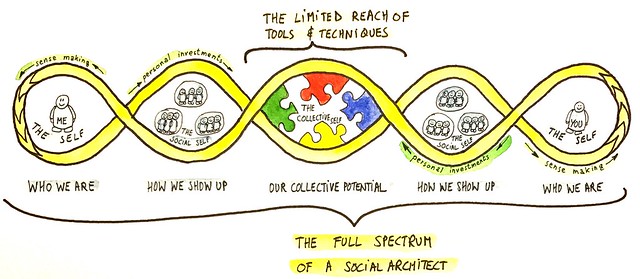
This is why a Social Architect needs a broad view in order to see people for who they really are: multi-layered bearers of gifts, who have the resourcefulness to recognize and acknowledge the gifts in others.
Social Architecture does not equal Leadership
We seem to have lost the notion that for organizations to become places where we can access possibilities that are unavailable to us as individuals, we need members to step in with their full Social Self. This is leadership.
It takes another role create the circumstances that invite the leadership of the Social Self in all members, to connect it to the leadership of other members and to hold the safe space in which the exploration of possibilities can take place. This is Social Architecture.
In short:
Leadership = how we take responsibility for the way we show up with our Social Self
Social Architecture = how we take responsibility for tapping into the potential of the Collective Self
When it is done right, i.e.: when members lead and when safe space is held, we access what neuroscientists call a ‘higher evolutionary intelligence’ of the collective self. Poets and storytellers on the other hand will refer to this exact same circumstance as ‘stone soup‘.
It is about how members engage in the construction of the narrative about their community and by doing so continuously reshape the story of who they are in turn.
In the end we have to conclude that Social Architecture is not about leadership and followership, but about holding space for leaders to develop. But just like flatlanders trying to grasp the concept of a third dimension, we needed to reverse some assumptions about leadership in order to get here.



